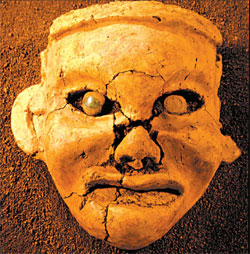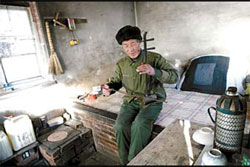| Tools: Save | Print | E-mail | Most Read |
| New Sensations from Ancient Wonders |
| Adjust font size: |
The head of the "Goddess of Hongshan", which was found on November 2,1983 at the ruins of the Temple of Goddess, is one of the most important parts of Niuheliang Hongshan cultural heritage. What is it like to look at a 120 million-year-old bird that has fossilised where it laid to rest? How does it feel to walk among 5,500-year-old remnants left behind by ancient Chinese? On a warm winter weekend I got my answers to these questions by traveling to Chaoyang City, in the western part of Northeast China's Liaoning Province. After an hour-long drive along the State 101 highway from downtown Chaoyang, I noticed piles of stones in the fields. "Here we are," said Meng Zhaokai, deputy director of Liaoning Hongshan Culture Research Institute. "This is one of the stone tombs of the Hongshan people," he said. Guarded with iron wire fences and no bigger than a football playground, the site looked quiet with wild grass swaying in the wind. In the stone tombs were piles of chipped rocks, either square or round. "It has remained the way it was 5,500 years ago," said Meng, pointing at a group of red round rocks in the grass. I knelt down and touched its rough surface. "What does it feel like?" one of my friends asked. "A bit cold," I joked. But at that moment I began to imagine that I might be touching the fingerprint of an ancient man.
Not far from the stone tombs stand the ruins of the Temple of Goddess, where archeologists found the head of a "Goddess of Hongshan" on November 2, 1983. The findings, which consist of altars, a temple and tombs, startled the world. Located on the border of Lingyuan and Jianping counties, the Niuheliang Site belongs to the Neolithic Hongshan Culture, which was created by tribes living in the west of the Liaohe River Valley about 5,000-6,000 years ago. The Hongshan Culture of the late Neolithic Age existed in today's Southeastern Inner Mongolian Autonomous Region, Western Liaoning and Northern Hebei provinces. The
Hongshan Culture was named in 1935 after the first site was discovered in Chifeng City, in Inner Mongolia Autonomous Region. The Goddess Temple is an important part of this culture. It consists of two groups of earthen and wooden constructions, with painted walls exhibiting triangular geometric patterns in reddish brown, interlaced with yellow and white. Dozens of fragments of sculpted human busts and hands were unearthed, including a life-sized head, red-painted faces, eyes, hands, shoulders, legs and breasts, which were the earliest goddess statues in China. A large number of animal statues, including jade dragons, resemble pig and bird. During the past two decades, Chinese archeologists have excavated 16 sites around the 50-square-kilometer-Niuheliang ruins. According to Meng, the most startling discovery came in 2003: a 3.9 x 3.1-meter stone grave at the No. 16 Site the largest grave ever found. The archeologists unearthed six tombs, collecting 470 relics in an area of 1,575 square meters, including a jade human figurine, a phoenix and a dragon. The jade articles were found well preserved in a stone coffin.
One of two rice-size relics is enshrined in this gold pagoda. Experts say the well-preserved skeleton of a male, about 45-50 years old in hard granite, must have been a wealthy man of high social status since he was buried with such fine artefacts. "The discovery provides important clues into the study of burial customs and religious and sacrificial rituals from 5,500 years ago," Meng said. As Meng explained the significance of the ruins, an elderly farmer approached us. Meng introduced him as one of the two guards protecting the No 2 Site. "I have been a guard for six years at this site," said Li Kuan, a 57-year-old farmer. Li added that he had been working a total of 20 years here switching between three sites. He and his partner Dong Jingyu take turns every two days on 24-hour watch of the site. They share a small house no bigger than 10 square meters at the corner of the site. Life is a bit boring. A kang or a brick bed occupied half of the space, leaving a little room for a table and a brick-made stove for both cooking and heating. There is no electricity and water. Li and his partner have to share 20 candles every month and they have to carry water from the river two kilometers away. When he is alone Li enjoys playing erhu. "That can kill the time during long winter nights since there is nobody to talk to," Li said. Li said there are guards on each of the 16 sites, most of who are local farmers. To protect the ruins, the local government removed three state-owned iron mines, three factories and 30 private mines. More than 10,000 villagers have moved to settle down away from the reserve. No wonder Li gets lonely. (China Daily March 7, 2007) |
| Tools: Save | Print | E-mail | Most Read |
 |
| Related Stories |
|



